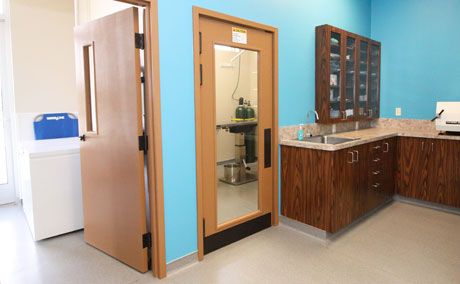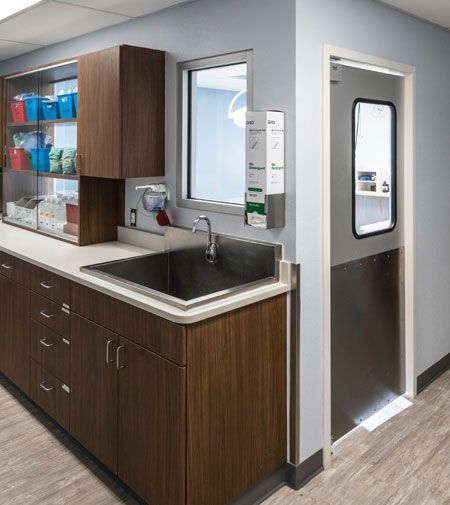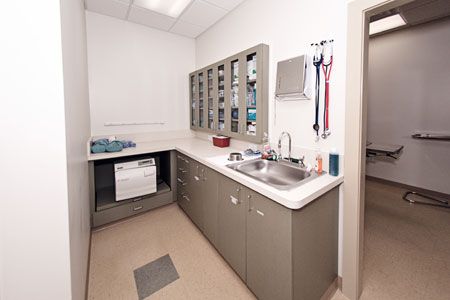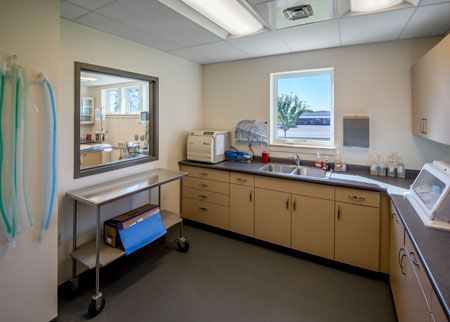Pack/prep/scrub smarts
With a little functional forethought, you can set yourself up for sterility when designing your veterinary hospitals pack/prep/scrub area.

The two-way swing door at Happy Tails Veterinary Care in Bethlehem, Georgia, aids in a sterile transition from surgery prep to surgery. Photo courtesy of Jennifer Wettstein, Wettstein Photography.If you aren't sure where to start when it comes to designing a pack/prep/scrub area, Heather Lewis, AIA, NCARB, of Animal Arts in Boulder, Colorado, has a suggestion: Think dirty.
In other words, begin by laying out the space so that dirty items can travel from surgery, to the soaking sink, to the sterilizer and finally to the packaging area linearly and logically.

Camden Village Animal Hospital in Johns Creek, Georgia, keeps the instrument sink separate from the hand scrubbing sink. Photo courtesy of Jennifer Wettstein, Wettstein Photography.Instrument scrubbing and hand scrubbing should always occur in separate sinks and should incorporate hands-free technology (such as foot pedals or infrared sensors), Lewis says. And while small hospitals can put both scrub sinks in the same area where the packing is done (the hand scrubbing sink should be on the clean side and the instrument sink on the dirty side), larger hospitals with multiple surgery rooms should keep scrubbing and pack prep separate. These will be busy areas, and separating them will help keep everything and everyone sterile, she says.

The pack/prep/scrub area in Southwest Veterinary Medical Center in Albuquerque, New Mexico, features a two-way swing door and enclosed, pass-through cabinets. Photo courtesy of Kirk Gittings, Kirk Gittings Photography.When it comes to designing the transition between the pack/prep/scrub area and the surgery area, Lewis again recommends thinking dirty. After you scrub, you want to get to the surgery room without touching any doors. This can be accomplished with a two-way swinging door that can be bumped open with your hip, or you can get a sliding door with an automatic sensor.
Making pack preparation functional is also really important, says Lewis. Larger hospitals with lots of instruments to pack may want an island layout or extendable counters or carts for extra space. Pass-through cabinets can be a smart way to store packs and have access to them from both the prep side and the surgery side. Enclosed cabinets are ideal because the packs will stay useable longer.
Read more Lewis logic on the next page...

ARKLE Veterinary Care in Smyrna, Georgia, put its autoclave on a sliding platform so it can be pulled out when in use and conveniently stored when not in use. Photo courtesy of Jolie Kimmel Rizzi, Jolie Loren Photography.Abbreviated autoclave advice
Autoclaves tend to be wider than the typical counter. Make sure your autoclave counter measures up before installation.
Talk to your architect about the type of autoclave you plan to use. Some large autoclaves have stands that require extra space, and others require hood vents above them to manage the steam they generate.
Don't put cabinets above your autoclave-regardless of whether or not it requires a hood vent-because they will be destroyed by the steam.

Petit Brook Veterinary Clinic in Colchester, Vermont, keeps its autoclave out in the open. Building a cabinet above your autoclave is a bad idea, as it will be destroyed by steam. Photo courtesy of Gary Hall, Gary Hall Photography.Surgical laundry list
Surgical laundry should be separate from regular hospital laundry.
Some hospitals use stackable washers and dryers in their pack prep area to save space.
If you can't take the noise, you can create a utility room for the washer and dryer off of the surgery area.